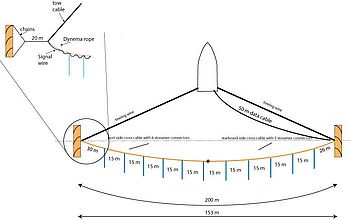Dr. Jörg Bialas
Phone: +49 (0)431 600-2329
jbialas(at)geomar.de
Prof. Dr. Christian Berndt
Phone: +49 (0)431 600-2273
cberndt(at)geomar.de
The P-Cable system design has been developed to enable 3-D high resolution imaging of shallow horizons from mid-size research vessels. GEOMAR is holding an academic license of the P-Cable system covering development and application.
Compared to standard reflection seismic applications in 2-D and 3-D the basic difference is that the P-Cable is build by a cross cable towed perpendicular to the ships heading (Fig. 1). Instead of a few single streamers the P-Cable uses a large number of short streamer sections towed parallel from the cross cable. Drawback is the limited depth penetration due to the short offsets, which do not allow the removal of the multiple. This is well compensated by the reduced costs of the system and the ability to operate it even from small multi-purpose vessels, the usual academic platform for marine research.
GEOMAR developed a modular cross cable, which allows exchanging each single streamer connector (node) in case of a malfunction. This allows easy service and reduced service costs. As well the modular design allows inserting connecting cables of different length between the nodes. Hence an adoption to different resolutions of the P-Cable are possible.

Actual design of the system enables up to 25 active breakouts with 10 m to 15 m long cross cable sections. The 300 m long cross cable is stretched by two trawl doors floating at the surface. Each trawl door delivers 2 tons pull at 4 kn speed.
Digital GeoEel Streamer (Geometrics) with 1.5 m group offset allow high resolution data acquisition. Network switches in the breakouts allow to add more than one streamer per node.
Positions of the trawl doors with real coordinates and relative distance to the vessel are provided within an online navigation package. Autonomous GPS receivers are mounted on each trawl door together with a serial radio link to the vessel (Fig. 2). On board the signal is displayed by software OFOP above a bathymetric chart. Along the track a display line connects the moving points of the two GPS positions from the trawl doors and allows following the expected coverage of the 3-D seismic system.
Airgun shots of one or two GI airguns were triggered by a GPS controlled timer.

